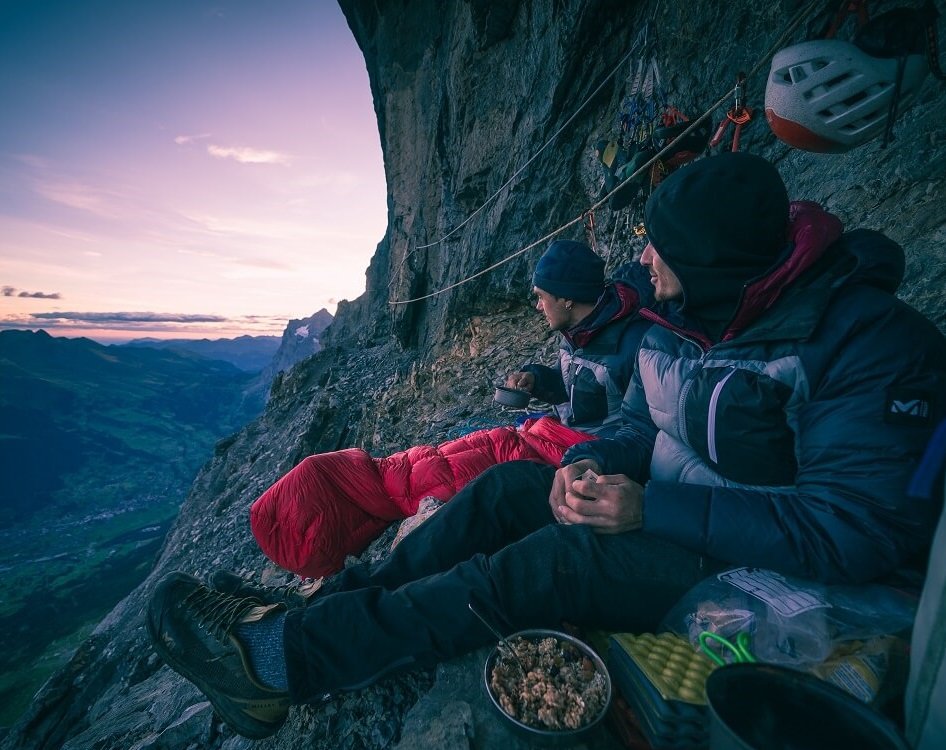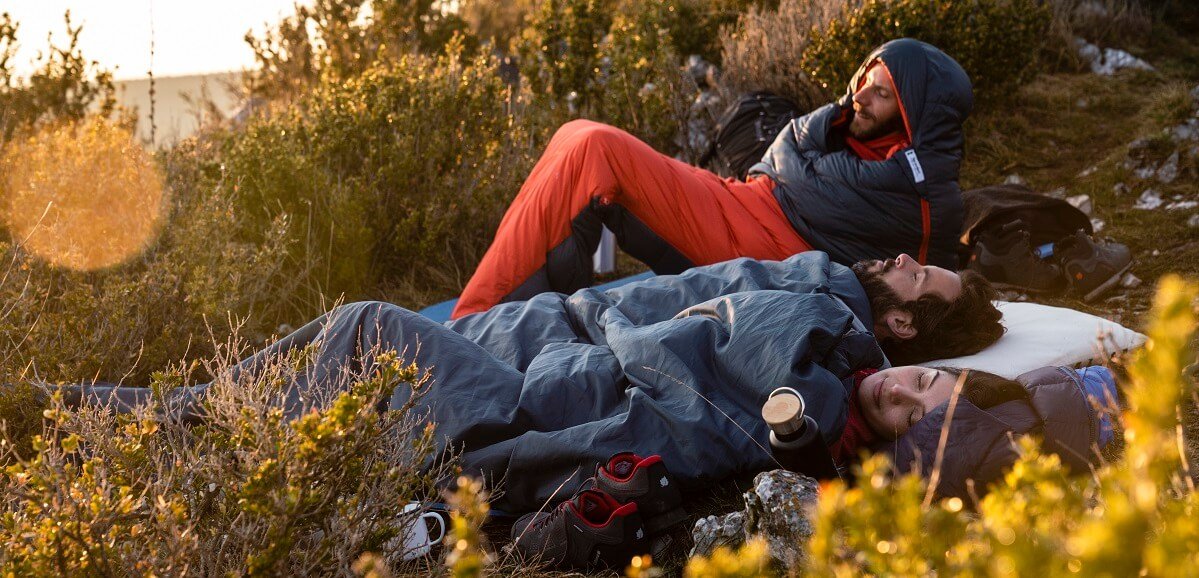Hiking, backpacking, trekking, mountaineering, choosing the right sleeping bag
Whether you're into hiking, trekking, climbing, or mountaineering, taking the time to find the right sleeping bag is crucial to ensure you spend pleasant nights under the stars, in a tent, or suspended to a cliff. To guide you in this important choice, we will explain the different characteristics to consider so you can head out backpacking with a sleeping bag that meets your needs. Bag shape, fill type, insulation capacity, comfort temperature, limit temperature or extreme temperature, we review everything to assist you in your choice based on your use, your sensitivity to the cold, and your needs.
Key takeaways
- Define your intended use (hiking, trekking, mountaineering) and your sensitivity to cold.
- Choose between natural down insulation or synthetic fill depending on weight, budget, and humidity levels.
- Opt for goose down and a high Fill Power rating if you tend to feel the cold easily.
- Synthetic sleeping bags are ideal for damp environments and for those on a tighter budget.
- Select a mummy-shaped bag for better thermal efficiency and reduced weight, or a rectangular bag for greater freedom of movement.
- Refer to the comfort temperature rating and season classification (1 to 4 seasons).
- Match the bag length to your height, allowing a little extra room.
- Check for a well-designed hood, draft collar, insulated foot box, and baffle construction to eliminate cold spots.
- Use a compression sack for transport, and store it uncompressed at home.
- Enhance comfort with an insulated sleeping mat, sleeping bag liner, bivvy bag, and a lightweight pillow.

What is the best material for a warm and protective sleeping bag?
Does down necessarily mean warmth?
There are two types of sleeping bag fill material, natural fill made of various proportions of feathers and down and synthetic fill. Each has its pros and cons, a natural fill offers better thermal insulation, while being lighter and more compressible, which makes it ideal in colder conditions and for treks where weight is of prime importance. The drawbacks being a more expensive price and more complicated care.
Down and Feather Insulation
Down has the ability to trap air, providing excellent insulation. However, down is not necessarily very warm; it all depends on its composition and fill power, that is, the proportion of down to feathers. A higher down content guarantees more warmth. A 90/10 sleeping bag contains 90% down and 10% feathers.
Goose Down or Duck Feathers?
You may wonder about the difference between goose down and duck down. Well, you're right to ask, because it's goose down and feathers that provide the best insulation against the cold, while also being lighter and more compressible than duck down. Go figure. So, if you're particularly sensitive to the cold, we advise you to pick goose down over duck down for this reason. And this is true not only for sleeping bags but also for down jackets.
Another thing to know to help you make the right choice: Fill Power (or FP) indicates the loft of down. It is expressed in Cuin. A down with a high FP traps air better and ensures better thermal comfort. So, don't be ashamed of being sensitive to cold. On the contrary, embrace it and protect yourself from the cold by enjoying the gentle warmth that goose down provides when it's bitterly cold.
Are synthetic fibre sleeping bags only meant for hiking/backpacking in summer?
While a sleeping bag with a synthetic fibre fill has lesser thermal insulation and a slightly higher weight compared to down, it does however resist moisture better and is more affordable. This type of sleeping bag is therefore to be preferred in damp weather and for hikes where the weight of your backpack is not the most critical criterion. Synthetic wadding dries quicker and retains its thermal efficiency even when wet. However, this type of sleeping bag tends to be less durable over time. If durability is your priority, we recommend a down sleeping bag over a synthetic fibre one.
|
Materials |
Pros |
Cons |
|---|---|---|
|
Natural fill (goose or duck feathers and down) |
Thermal insulation Compressible Lightness |
Cost Trickier cleaning |
|
Synthetic fill |
Abordable Easy cleaning Quick drying |
Thermal insulation Not as durable |
Which type of sleeping bag to choose: mummy or quilt?
The shape of your sleeping bag is also an important element and must meet your needs. The two main families are mummy bags and quilt/rectangular-shaped bags.
Mummy Sleeping Bags
With their anatomical shape, mummy sleeping bags have a reduced air volume that retains heat more easily, thus offering better insulation. They are also lighter and more compact. The mummy shape is recommended for mountaineering, treks where low bulk and weight are important criteria, but also for people who are sensitive to cold. However, it's worth noting that they are generally more expensive, and the limited foot space may feel uncomfortable for some people.
Quilt/Rectangular Sleeping Bags
More affordable financially, these sleeping bags offer a greater interior volume, allowing for easier movement. The downside is less efficient insulation due to the larger quantity of air to warm up. We recommend them to anyone who fears feeling constricted in a mummy bag, because even though they are a bit heavier and bulkier, they are very comfortable.
Choosing the right temperature
4 season sleeping bag, comfort, limit and extreme temperature ratings, understanding the classifications
Among the technical characteristics generally present on sleeping bags products sheets, you will find the comfort rating, limit rating, and extreme rating.
- The comfort rating is the temperature in which you will spend a pleasant night.
- The limit rating is the temperature in which you will probably feel cold but remain safe.
- The extreme rating is the point at which discomfort turns into potential hypothermia.
When choosing a sleeping bag, you should refer to the comfort temperature rating and pick a model that matches the temperature in which you plan to sleep in.
4-Season, 3-Season Sleeping Bags: Which to Choose?
Many sleeping bags are categorised according to ‘seasons’. Here is what this rating means:
- 1-season sleeping bags are ideal for summer use under a tent or under the stars. They can also be suitable for indoor use in a shelter, a cottage, at friends' homes, or in heated rooms during winter.
- 2-season sleeping bags are suitable for spring and summer in temperate climates.
- 3-season sleeping bags offer the greatest versatility. They are suitable for use all year round for many outdoor activities, except for winter, for which a 4-season model is better.
- 4-season sleeping bags are designed for high-altitude wild camping, in very cold weather, whether you're going on a 2-day hike, a trekking expedition, or a mountaineering route.
How to choose the size of a sleeping bag?
To spend a pleasant camping night, your sleeping bag should be the right length. Whether it is a mummy or rectangular sleeping bag, the size is chosen differently. For a mummy shaped sleeping bag, opt for a bag 25 to 30 cm longer than your size. For a rectangular shaped sleeping bag, you only need 5 to 10 cm extra. For instance, someone 180 cm tall will need a 205 to 210 cm mummy sleeping bag or a 185 to 190 cm rectangular sleeping bag.
What are the other elements to take into account?
To narrow down your choice, we now need to turn to other features and technical characteristics that may help you select the right model.
Zipper System and Pairing Possibility
The zipper system is located either on the right or the left side. The choice of zipper side depends on your personal preference. To help you decide, it's generally easier for a right-handed person to use a left-sided zipper and vice versa.
The zipper system sometimes allows for pairing two sleeping bags together. This is very practical for a couple who wish to have the option to sleep together, but beyond what might be seen as the sole advantage, it allows for mutual warmth when temperatures are low (from 0°C and below).
Hood, flaps and draft collar
Sleeping bags designed for cold conditions feature zippers with storm flaps to improve thermal insulation and prevent heat loss.
In colder temperatures, a hood is key, as most of your body’s heat loss occurs from the head. A draft collar is also critical to prevent cold air from entering the sleeping bag around the shoulder area.
In the same way as the hood to protect your head, the feet area called footbox should be well insulated as this part of the body is particularly sensitive to the cold. It would be a shame if your nights outside were ruined by cold feet.
Baffles
The number, shape and pattern of baffles in which the fill is spread also play an essential role in how warm a sleeping bag is. Baffles keep the fill in place to prevent cold spots.
Storage pocket and compression sack
Numerous sleeping bags feature a storage pocket to keep small items you want to keep warm close to you. It can be electronic devices such as your GPS, smartphone, or a lamp to keep it on hand.
The compression sack should not be neglected, it keeps your sleeping bag compact during your adventures, preventing it from taking too much space in your hiking backpack. Please keep in mind that a compression sack should not be used to store your sleeping bag which should be stored away from moisture, hung or in a dedicated storage sack to retain its fill power.
What Other Accessories Should You Pack?
Mattress
A camping mattress not only improves your comfort by protecting you from the ground, but it also helps to insulate you from the cold.
Sleeping Bag Liner
The sleeping bag liner is a very useful item that protects your sleeping bag from dirt, improves hygiene, and provides an additional layer of warmth, which can vary depending on the material it is made from.
The Bivy Bag
If you prefer to travel light and decide to forego a tent for sleeping, it is essential to pack a bivy bag. Extremely light and compact, the bivy bag can be an ideal partner if you wish to have the lightest equipment possible. It protects your sleeping bag from moisture to keep it dry and also shelters you from the wind.
Pillow
For greater comfort, you might choose a pillow that is relatively lightweight and compact.
Fill, shape, size, you now know how to choose your sleeping bag
Now, you know all the elements to consider when choosing a sleeping bag based on the conditions encountered during backpacking. Whether you're planning a simple weekend with family or friends, considering hiking/backpacking often, preparing for a trek on the other side of the world, or a mountaineering route, you'll find sleeping bags suitable for all situations at Glisshop. Should you have any doubts, we are at your disposal to help you make the right choice.

